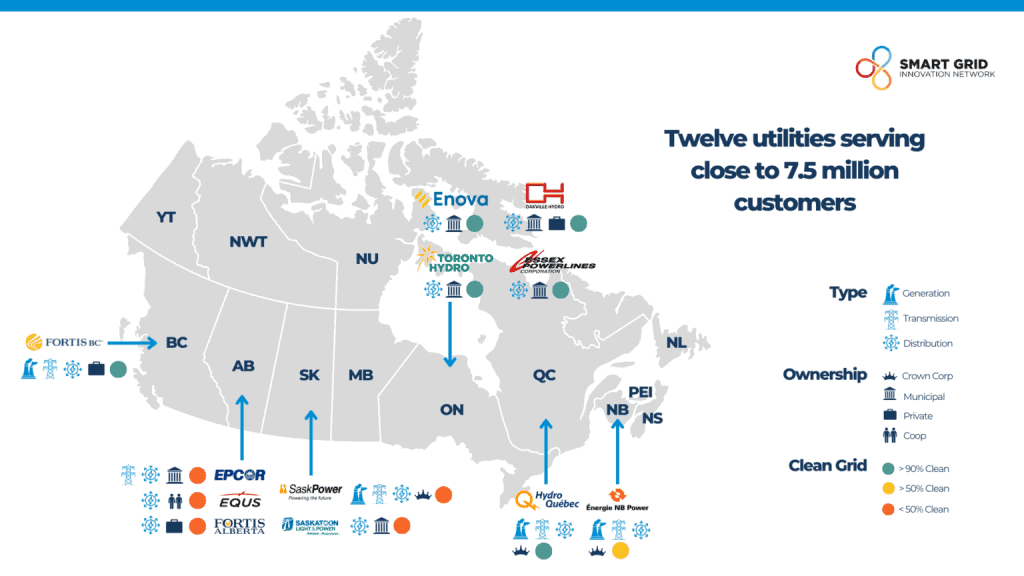Challenge: Understand how far along Canadian electric utilities are with respect to decarbonizing their energy supply, growing a modern grid, and supporting customers in the energy transition.
Solution: Support capacity building and knowledge sharing among utilities through a “Smart Energy Scorecard” that benchmarks progress made by participating Canadian electric utilities.
Impact: Establishing a national baseline from which utilities can acquire knowledge and build their capabilities, and from which policymakers can make more informed investment and regulatory decisions.
Electric Utilities: Key Actors in the Energy Transition
To power Canada’s low-carbon economy, our electricity system must continue to be reliable, safe and affordable, but also clean, resilient, and equitable. Getting there will be a significant challenge; utilities must simultaneously decarbonize existing supply and expand the system’s energy use to accommodate the 2-3x growth in demand expected by 2050, as we electrify vehicles, buildings, and industry.
To help utilities meet this challenge, Dunsky partnered with the Smart Grid Innovation Network (SGIN), Siemens, and the University of New Brunswick to develop a three-phase, Smart Energy Benchmarking Initiative. Its objective is to help Canadian electric utilities acquire the knowledge, skills, and tools to incorporate renewable energy, modernize the grid, and support equity, diversity and inclusion.
The first phase of this work – a scorecard to benchmark utility efforts and progress towards a clean, modern and customer-centric grid – was developed by Dunsky in collaboration with participating utilities. It represents a comprehensive, robust and utility-supported framework to assess electric utility decarbonization efforts and progress.
The scorecard includes 140+ indicators across 13 metrics that collectively assess the progress of participating utilities towards three core goals: 1) cleaning energy supply, 2) transitioning to a modern grid, and 3) enabling customers and society goals.
The project delivers on three critical objectives:
- Celebrating Canadian utility leadership in the energy transition;
- Building the capacity of participating utilities to prepare for the energy transition by helping them understand where they are starting from, how they compare to peers, and where they need to go; and
- Capturing key insights that can support other utilities on their pathways, as well as inform the efforts of other stakeholders.
Participating Utilities
Twelve utilities from across six provinces voluntarily participated in the scorecard. Collectively these 12 utilities serve close to 7.5 million customers, representing almost half of electric utility customers in Canada. They also represent Canada’s diverse electricity sector in terms of their size, type, ownership, regulatory structure, and clean energy supply.

What We Learned
The 12 utilities, unsurprisingly, are at different stages of the decarbonization process.
Yet whether a utility is a national leader, or just getting started, all 12 demonstrated leadership across certain metrics and indicators. Several benefited from having a relatively clean or non-emitting grid, but utilities shone in other indicators such as corporate leadership, enhanced grid planning and management, climate resiliency, comprehensive electrification strategies, customer engagement, and equity, diversity, and inclusion initiatives.
More broadly, results from the benchmarking highlight insights on the broader progress and pathways for Canadian utilities’ decarbonization journey. These insights include:
- Everyone is on board: Although they are at various stages of progress, Canadian utilities have recognized the urgency to prepare their grids and organizations for the energy transition.
- No one size fits all: The diversity of Canadian utilities matches the diversity of Canada’s energy markets. While learnings can – and should – travel across provincial boundaries, the unique regulatory and market contexts each utility operates in must be considered when comparing progress, ambition, and pathways to net-zero.
- Utility innovation is a necessary driver of the transition: While utilities have historically been viewed as risk-averse, there is increasing recognition and momentum that utilities have a critical role to play in enabling and leveraging Distributed Energy Resources (DERs), smart grid technologies and other innovations to support the energy transition.
- Utilities can’t do it alone: Utilities are facing a massive transformation, and they cannot do it alone. Policy and regulatory frameworks must keep up with the magnitude and pace of change in the sector to remove barriers that constrain utility efforts, and to help utilities to deliver on their expanded mandates.
- The Energy Transition is an Opportunity: The pace and magnitude of change required for the energy transition can be a challenge; however, it is equally an opportunity. This includes the opportunity to enhance our power system’s resiliency and reliability, achieve long-term operational cost savings, create economic opportunities, empower our communities, secure a competitive advantage and ensure a more sustainable future for all Canadians
To read in-depth utility results and insights, please consult the report.
About Dunsky Energy + Climate Advisors
Dunsky supports leading governments, utilities, corporations and others across North America in their efforts to accelerate the clean energy transition, effectively and responsibly. With deep expertise across the Buildings, Mobility, Industry and Energy supply sectors, our team of 50+ professionals supports clients in two ways: through rigorous Analysis (of technical, economic and market opportunities) and by designing or assessing leading Strategies (plans, programs and policies).


